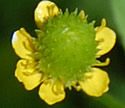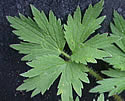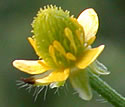Ranunculus pensylvanicus (Pennsylvania Buttercup)
| Also known as: | Bristly Buttercup, Bristly Crowfoot |
|---|---|
| Genus: | Ranunculus |
| Family: | Ranunculaceae (Buttercup) |
| Life cycle: | annual, short-lived perennial |
| Origin: | native |
| Habitat: | part shade, sun; wet fields, ditches, marshes, along shores |
| Bloom season: | June - August |
| Plant height: | 1 to 3 feet |
| Wetland Indicator Status: | GP: FACW MW: OBL NCNE: OBL |
| MN county distribution (click map to enlarge): |  |
| National distribution (click map to enlarge): |  |
Pick an image for a larger view. See the glossary for icon descriptions.
Detailed Information
Flower: 
![[photo of flower]](/udata/r9ndp23q/pd/ranunculus-pensylvanicus-10-t.jpg) Flowers are at the ends of branching stems and stalks that arise from the leaf axils near the top of the plant. Individual flowers are 1/8 to ¼ inch across with 5 shiny yellow rounded petals. There is a ring of yellow-tipped stamens around a bulbous yellowish center that turns bright green with maturity. The 5 green sepals are longer than the petals, covered in long hairs on the outer surface, and typically bend back away from the flower (reflexed).
Flowers are at the ends of branching stems and stalks that arise from the leaf axils near the top of the plant. Individual flowers are 1/8 to ¼ inch across with 5 shiny yellow rounded petals. There is a ring of yellow-tipped stamens around a bulbous yellowish center that turns bright green with maturity. The 5 green sepals are longer than the petals, covered in long hairs on the outer surface, and typically bend back away from the flower (reflexed).
Leaves and stem: 


![[photo of leaves]](/udata/r9ndp23q/yellow/pennsylvania-buttercup_0811_164217-t.jpg) Leaves are compound in 3's, with leaflets (usually) deeply divided into 3 wedge-shaped to elliptical segments that are further lobed, notched and/or coarsely toothed. Leaflets are up to 3 inches long and 2 inches wide, becoming smaller as they ascend the stem, and are hairy. Attachment is alternate.
Leaves are compound in 3's, with leaflets (usually) deeply divided into 3 wedge-shaped to elliptical segments that are further lobed, notched and/or coarsely toothed. Leaflets are up to 3 inches long and 2 inches wide, becoming smaller as they ascend the stem, and are hairy. Attachment is alternate.
![[photo of stem]](/udata/r9ndp23q/yellow/pennsylvania-buttercup_0720_092528-t.jpg) Leaves near the base of the plant have long stalks that sheath the stem. These often wither away early. The stem and leaf stalks are both densely covered in stiff hairs, becoming more sparsely hairy with age.
Leaves near the base of the plant have long stalks that sheath the stem. These often wither away early. The stem and leaf stalks are both densely covered in stiff hairs, becoming more sparsely hairy with age.
Fruit: 
![[photo of fruit]](/udata/r9ndp23q/yellow/pennsylvania-buttercup_0713_102151-t.jpg) The flower center expands to a cylindrical seed head about ½ inch long. Seeds are tear drop shaped, flattened, with a narrow rib or wing around the edge and a mostly straight beak.
The flower center expands to a cylindrical seed head about ½ inch long. Seeds are tear drop shaped, flattened, with a narrow rib or wing around the edge and a mostly straight beak.
Notes:
A common wetland plant, Pennsylvania Buttercup most closely resembles Macoun's Buttercup (Ranunculus macounii), which has very similar leaves and densely hairy stems, but much larger flowers—about ½ inch across—and sepals shorter than the petals. R. macounii is also limited to the northwest counties where R. pensylvanicus is found throughout the state.
Native Plant Nurseries, Restoration and Landscaping Services ↓
More photos
 Pennsylvania Buttercup plant
Pennsylvania Buttercup plant Pennsylvania Buttercup plant
Pennsylvania Buttercup plant an atypical 6-petaled flower
an atypical 6-petaled flower early growth
early growth flowers with reflexed sepals
flowers with reflexed sepals
Photos by K. Chayka taken at Long Lake and Vadnais/Snail Lake Regional Parks, Ramsey County. Photos courtesy Peter M. Dziuk taken in Anoka County.
Comments
Have you seen this plant in Minnesota, or have any other comments about it?
on: 2015-05-19 20:43:30
I live in Highland Park area of St. Paul. This seems to be the plant that has overtaken much of my back garden this spring! Ours has small petals that are very oval and stand upwards, like a cup, but the center stamen cluster is smaller than the photo. However, most of the description fits, and the leaf shapes are accurate. Is this invasive? What is it good for? I have torn out a large portion of them to save my daisies and tiger lilies, but wonder if this is worth keeping? Thanks, if you can advise.
on: 2015-05-21 19:06:15
Dixie, personally I would keep the native Ranunculus and get rid of the foreign daisy and lily species. But that's me :)
on: 2019-02-26 16:58:57
In a marshy area under meadow willow.






